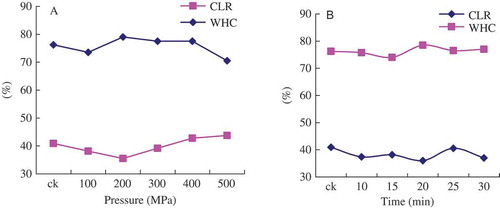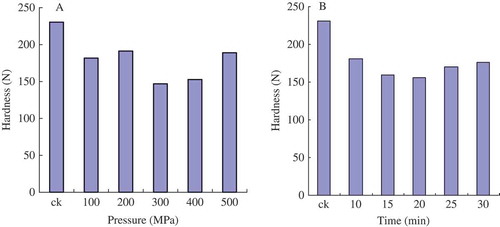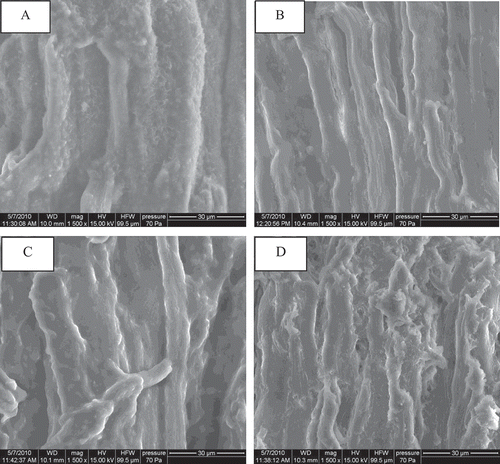Abstract
Ultra-high pressure treatment was used to tenderize the goose meat. The conditions of ultra-high pressure were optimized by response surface methodology. Goose meat was subjected to ultra-high pressures of 100, 200, 300, 400, and 500 MPa for 10, 15, 20, 25, and 30 min at 20°C, respectively. Subsequently the cooking loss rate, water holding capacity, texture, and scanning electron microscope of the products were determined. The pressure and holding time significantly influenced the hardness values (p < 0.05), but did not significantly affect cooking loss rate and water holding capacity (p > 0.05). The hardness significantly decreased after ultra-high pressure treatment. Scanning electron microscope analysis showed that fracture of the rod-like muscle was observed in ultra-high pressure treated samples. Response surface methodology results showed that pressure (213 MPa) and holding time (15.35 min) at 20°C was helpful to decrease the hardness of goose breast.
INTRODUCTION
High pressure processing technology (HPP) was originally developed in 1899 and had been successfully used in the chemical, ceramic, steel, food, and plastic industries.[Citation1,Citation2] In 1973, Macfarlane[Citation3] investigated the effect of HPP on the texture of muscle foods and reported the potential use of HPP for pressure-induced tenderization of meat. Since then, many authors have reported that pre-rigour treatment for a few minutes at 100–200 MPa induces meat tenderization.[Citation4] Tenderization is an effective method which can improve the eating quality of meat so as to meet consumer satisfaction and repeat purchase of meat.[Citation5] Pressure could induce unfolding of protein and subsequent aggregation lead to the formation of gels, which will affect the textural quality of the food. Proteins or complex biopolymers subjected to high pressure may have their structure modified by disruption of hydrophobic and electrostatic interactions.[Citation6] Proteins gels induced by pressure were glossier, smoother, softer, and have greater elasticity, which were different from those induced by heat.[Citation7] Previous research has been applied to the HPP of minced beef, cod muscle, turbot muscle, poultry batters, poultry sausage,[Citation8−Citation11] but little research has been done on goose meat. Goose meat has the characteristics such as nutrient-rich, low fat, and high content of unsaturated fatty acid, which is very beneficial to human health. In addition, protein content of goose meat is higher than duck, chicken, beef, and pork, and the lysine content is higher than the broiler. The aim of this research was to investigate the combination effects of pressure (100–500 MPa) and holding time (10–30 min) on the physical properties of goose meat and to optimize the conditions of ultra-high pressure by response surface methodology (RSM).
MATERIALS AND METHODS
Materials
Fresh goose breast was obtained from a local meat market. The goose meat was frozen to –18°C in a freezer and stored at –18°C. Before high pressure treatment, the meat was thawed at 4°C for 18 h to approximately 0°C.
High-Pressure Treatment
Goose breast was trimmed to remove visible fat and connective tissue, along the fiber direction cut into blocks with size of 30 mm × 30 mm × 25 mm, then vacuum sealed with cooking bags in order to remove the air. The goose meat samples were treated immediately with ultra-high pressure after package. Packaged goose breast were pressurized using a high pressure rig (Baotou Kefa New Type Hi-tech Food Machine Limited company, China) at 100, 200, 300, 400, and 500 MPa at 20°C with holding time of 10, 15, 20, 25, and 30 min, respectively. Water of 10°C was used as the pressurizing medium.
Cooking Loss Rate (CLR)
After high-pressure treatment, the goose breast (20 g) was placed in cooking bags and heated 10 min at 95°C, then taken out and drained surface water with filter paper. The weight of sample was recorded after cooking (W) and the CLR was expressed using Eq. (1).
Scanning Electron Microscopy
Small pieces from the control and ultra-high pressure-treated muscles were fixed with 10% formaldehyde in 0.1 M phosphate buffer, pH 7.0, for 24 h. The pieces were put in a solution of 1% tannic acid for 3 h, rinsed with distilled water for several hours, and post-fixed with 1% osmium tetraoxide-0.1 M phosphate buffer, pH 7.0, for 1 h, and buried a few hours with liquid paraffin. Then cut into 1 mm slices and stained with eosin. The specimens were dried by freeze-drying method. The dried specimens were coated with gold and examined using a SEM (Quanta 200, FEI, USA).
Moisture and Water-Holding Capacity (WHC)
Moisture content (W1) of goose meat sample was determined by the AOAC (1995) method. WHC was determined according to the following method. Minced goose meat (20 g) was placed in a centrifuge tube containing 30 mL of 0.6 M NaCl and was stirred with glass rod for 1 min. Then the tube was kept at 41°C for 15 min, stirred again and centrifuged at 4000 g (R-24, Remi Instruments, India) for 20 min. The weight of precipitate was measured (W2) and WHC was calculated according to Eq. (2).
Instrumental Texture Profile Analysis (TPA)
TA-XT2i (Stable Micro System, England) was used to conduct TPA of pressure treated and control cubical goose breast samples (30 × 30 × 25 mm) according to Wang et al.[Citation12] with some modification. A double compression cycle test was performed up to 50% compression of the original portion height with an aluminum cylinder probe of 50 mm diameter (P/50). The method was conducted under these conditions: pre-test speed, 2 mm/s; test speed, 2 mm/s; post-test speed, 2 mm/s; measurement distance, 50% deformation; time, 10 s. All measurements were performed in triplicate using three cubical goose breast samples per treatment.
Experiment Design
One response was measured: Hardness (Y), defined as the peak force required to compress the samples. Each of variables to be optimized was coded at three levels: –1, 0, and 1. showed the variables, their symbols, and levels. The selection of variable levels was based on the study of different pressure and different treatment time. showed the central composite design (CCD), arranged to allow for fitting of a second-order model. The CCD combined the vertices of a hypercube whose coordinates are given by the CCD with the “star” points. The star points were added to the factorial design to provide for estimation of curvature of the model. Five replicates (run 9–13) at the center of the design were used to allow for estimation of “pure error” sum of squares. Experiments were randomized in order to minimize the effects of unexplained variability in the observed response due to extraneous factors.
TABLE 1 Variables and their levels for central composite design
TABLE 2 Central composite design arrangement and response
Statistical Analysis
A software package (Design Expert 7.0) was used to fit the second-order models and generate response surface plots. The model proposed for the response (Y) was:
where, b0 is the value of the fitted response at the center point of the design, which is point (0, 0). Bn, bnn, and bnm are the linear, quadratic, and cross-product regression terms, respectively.
RESULTS AND DISCUSSION
Effect of Different Pressure on CLR and WHC of Goose Breast
showed the effects of different pressure on CLR and WHC of goose breast. The CLR decreased with the increase of pressure, and the lowest was obtained at pressure 200 MPa. While the CLR increased with the increase of pressure. The CLR of goose breast was lower than that of control sample at the pressure range 100–300 MPa. The WHC of goose breast was stable at the range of 200–400 MPa while went down more at pressure 500 MPa.
Effect of Different Time on CLR and WHC of Goose Breast
showed the effect of different treatment time on CLR and WHC of goose breast when pressure was fixed at 300 MPa. The CLR values of the samples treated by high pressure were relatively lower than that of the control when treated time was at the range of 10–20 min. The highest WHC of goose breast was obtained at the treated time 20 min.
Effect of Different Pressure on Textural Properties
The texture plot for goose breast samples treated with different pressure (treated time: 20 min) are presented in . The hardness of all the samples after pressure treatment was lower than the control sample and the lowest was found at 300 MPa. This clearly indicated that the application of high pressure improved the tenderness of goose breast meat. It was well recognized that high hydrostatic pressure induced protein denaturation and gel formation[Citation13−Citation16] at room or refrigerated temperature. While the hardness values increased when treated pressure exceeded 300 MPa. Ashie and Simpson[Citation17] have reported the effects of pressures up to 300 MPa on the texture of blue fish and found that although samples treated at 300 MPa appeared harder by sensory examination, instron compressive probe measurements indicated they were softer. Their results were rather variable. Comparisons of the texture profiles of the pressure-treated samples with the thermograms very strongly suggested that the loss of myosin structure led to the decrease in adhesiveness, gumminess, and cohesiveness. In contrast, an increase in springiness and subsequent unfolding of the actin (and sarcoplasmic proteins) above 400 MPa led to the increase in gumminess, hardness, and adhesiveness.
High pressure treatment as a relative new technique was used to tenderize meat. To date, there have been a large number of articles published on accelerated tenderization of meat during conditioning (ageing) which results from structural changes of the myofibrils caused by high pressure. HPP has been shown to influence the structure and function of muscle proteins.[Citation13,Citation17,Citation18] With increased pressure muscle fibers become finer and more compact.[Citation19] Pressurization of beef has been shown to reduce sarcomere length.[Citation20] In the semitendinosus (ST) muscles cooking loss increased gradually with increasing pressure up to 300 MPa, this maybe cause to increase the tenderness of meat.
Effect of Different Treatment Time on Textural Properties
The texture plot for goose breast samples treated with different time (pressure: 300 MPa) are presented in . Within the experimental conditions of the study, the hardness of goose breast samples decreased after treated by different pressure-holding time and the lowest was found at the treatment time of 20 min.[Citation21] Bouton and others[Citation22] found that a pressure of about 200 MPa applied for 2.5 min or longer to post-rigor muscle improved the tenderness of the meat. The longer of time treated by high pressure, the softer the muscle fibers become.[Citation23]
Scanning Electron Microscopy
The connective tissue plays an important role in determining the eating quality of meat. Scanning electron micrographs of the intramuscular connective tissue in the control and the treated goose meats were shown in . The fracture of the rod-like muscle was only slightly observed in 200 MPa treated sample () as compared with that of the control (). The fracture probably caused by the decomposition of pressure. But the muscle texture became more delicate and smooth of cross section of the samples treated by 300 MPa (). The muscle was seriously ruptured in the samples treated by 400 MPa ().
RSM
Diagnostic checking of the fitted model
According to the experiment design, ANOVA for the regression was performed to assess the “goodness of fit.” The model for hardness (Y) was:
The result of ANOVA showed the model F-value of 6.48 implies the model was significant. There was 1.47% chance that a “model F-value” this large could occur due to noise. Values of “Prob > F” less than 0.05 indicated model terms were significant. The “lack-of-fit F-value” of 0.8073 implies the lack-of-fit was not significant.
Response Surface Plotting
Variables giving quadratic and interaction terms with the largest absolute coefficients in the fitted models were chosen for the axes of contour plots to account for curvature of the surfaces. In , pressure and treated time were selected for the vertical and horizontal axes, respectively, for the contour plot () and 3D-surface () of hardness content. Response surface contour plots of the RSM as a function of two factors at a time, holding all other factors at fixed levels, are more helpful in understanding both the main and the interaction effects of these two factors. These plots can be easily obtained by calculating from the model, the values taken by one factor while the second varies (from –1 to +1, step 1 for instance) with constraint of a given Y value (hardness). The hardness for different concentrations of the variables can also be predicted from the respective response surface contour plots.
Optimization Based on Hardness of Goose Breast
The model is useful in indicating the direction in which to change variables in order to hardness. The model for Y indicated that pressure and time were the major variables affecting hardness. By using Design Expert 7.0 software, the optimum condition were the pressure 213 MPa and time 15.35 min could be recommended as a practical optimum. The estimated values for hardness 151.06 N was obtained at those conditions. A verification experiment at the optimum condition, consisting of three runs, was performed and the hardness of 149.31 ± 0.12 N (n = 3) was obtained.
CONCLUSION
Within the range of experimental conditions studied, 300 MPa treatment (up to 20 min holding time) yielded meat samples with minimum hardness. Optimum production conditions could be achieved by RSM at 213 Mpa treatment (up to 15.35 min holding time), and the estimated values for hardness 151.06 N was obtained at those conditions. Response surface contour and 3D-surface suggested the interaction effects of these two factors.
FUNDING
This study was funded by Program for Innovative Research Team (in Science and Technology) in University of Henan Province (13IRTSTHN006), Science and Technology Projects in Henan Province (Nos. 132102110032, 2010A550005, 13A550288, and 12B550003) and key teachers funding Scheme in Henan Province (2010GGJS-141).
Additional information
Funding
REFERENCES
- Norton, T.; Sun, D. Recent advances in the use of high pressure as an effective processing technique in the food industry. Food and Bioprocess Technology 2008, 1, 22–34.
- Torres, J.A.; Velazquez, G. Commercial opportunities and research challenges in the high pressure processing of foods. Journal of Food Engineering 2005, 67, 95–112.
- Zuckefwan, H.; Solomon, M.B. Ultrastructural changes in bovine longissimus muscle caused by the Hydrodyne process. Journal of Muscle Foods 1998, 9, 419–426.
- Campus, M.; Addis, M.F.; Cappuccinelli, R.; Porcu, M.C.; Pretti, L.; Tedde, V.; Secchi, N.; Stara, G.; Roggio, T. Stress relaxation behaviour and structural changes of muscle tissues from Gilthead Sea Bream (Sparus aurata L.) following high pressure treatment. Journal of Food Engineering 2010, 96, 192–198.
- Bekhit, A.E.A.; Carne, A.; Ha, M.; Franks, P. Physical interventions to manipulate texture and tenderness of fresh meat: A review. International Journal of Food Properties 2014, 17, 433–453.
- Apichartsrangkoon, A. Effects of high pressure on rheological properties of soy protein gels. Food Chemistry 2003, 80, 55–60.
- Sun, X.D.; Holley, R.A. High hydrostatic pressure effects on the texture of meat and meat products. Journal of Food Science 2010, 75, 17–23.
- Canto, A.C.V.C.; Lima, B.R.C.C.; Cruz, A.G.; Lázaro, C.A.; Freitas, D.G.C.; Faria, J.A.F. Effect of high hydrostatic pressure on the color and texture parameters of refrigerated Caiman (Caiman crocodilus yacare) tail meat. Meat Science 2012, 91, 255–260.
- Chevalier, D.; Le Bail, A.; Ghoul, M. Effects of high pressure treatment (100–200 MPa) at low temperature on turbot (Scophthalmus maximus) muscle. Food Research International 2001, 34, 425–429.
- Ma, H.; Ledward, D.A. High pressure/thermal treatment effects on the texture of beef muscle. Meat Science 2004, 68, 347–355.
- Mor-Mur, M.; Yuste, J. High pressure processing applied to cooked sausage manufacture: Physical properties and sensory analysis. Meat Science 2003, 65, 1187–1191.
- Chang, H.K.J; Wang, Q; Xu, X.L.; Li, C.B.; Huang, M.; Zhou, G.H.; Dai, Y. Effect of heat-induced changes of connective tissue and collagen on meat texture properties of beef semitendinosus muscle. International Journal of Food Properties, 2011, 14, 381–396.
- Hsu, K.C.; Ko, W.C. Effect of hydrostatic pressure on aggregation and viscoelastic properties of tilapia (Orechromis niloticus) myosin. Journal of Food Science 2001, 66, 1158–1162.
- Ko, W.C.; Jao, C.L.; Hsu, K.C. Effect of hydrostatic pressure on molecular conformation of tilapia (Orechromis niloticus) myosin. Journal of Food Science 2003, 68, 1192–1195.
- Ma, H.; Ledward, D.A. High pressure processing of fresh meat—Is it worth it? Meat Science 2013, 95, 897–903.
- Ashie, I.; Simpson, B.K. Application of high hydrostatic pressure to control enzyme related fresh seafood texture deterioration. Food Research International 1996, 29, 569–575.
- Kruk, Z.A.; Yun, H.; Rutley, D.L.; Lee, E.J.; Kim, Y.J.; Jo, C. The effect of high pressure on microbial population, meat quality, and sensory characteristics of chicken breast fillet. Food Control 2011, 22, 6–12.
- Tokifuji, A.; Matsushima, Y.; Hachisuka, K.; Yoshioka, K. Texture, sensory, and swallowing characteristics of high-pressure-heat-treated pork meat gel as a dysphagia diet. Meat Science 2012, 93, 843–848.
- Duranton, F.; Simonin, H.; Chéret, R.; Guillou, S.; de Lamballerie, M. Effect of high pressure and salt on pork meat quality and microstructure. Journal of Food Science 2012, 77, 188–194.
- Jung, S.; Ghoul, M.; de Lamballerie-Anton, M. Changes in lysosomal enzyme activities and shear values of high pressure treated meat during ageing. Meat Science 2000, 56, 239–246.
- Galazka, V.B.; Smith, D.; Ledward, D.A.; Dickinson, E. Complexes of bovine serum albumin with sulphated polysaccharides: Effects of pH, ionic strength, and high pressure treatment. Food Chemistry 1999, 64, 303–310.
- Ratcliff, D.; Bouton, P.E.; Ford, A.L.; Harris, P.V.; Macfarlane, J.J.; O’shea, J.M. Pressure-heat treatment of post-rigor muscle: Objective-subjective measurements. Journal of Food Science 1977, 42, 857–859.
- San, M.M.F.; Barbosa-Cánovas, G.V.; Swanson, B.G. Food processing by high hydrostatic pressure. Critical Reviews in Food Science and Nutrition 2002, 42, 627–645.




